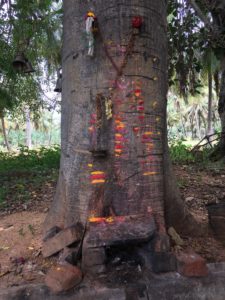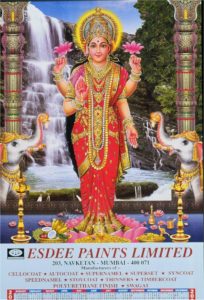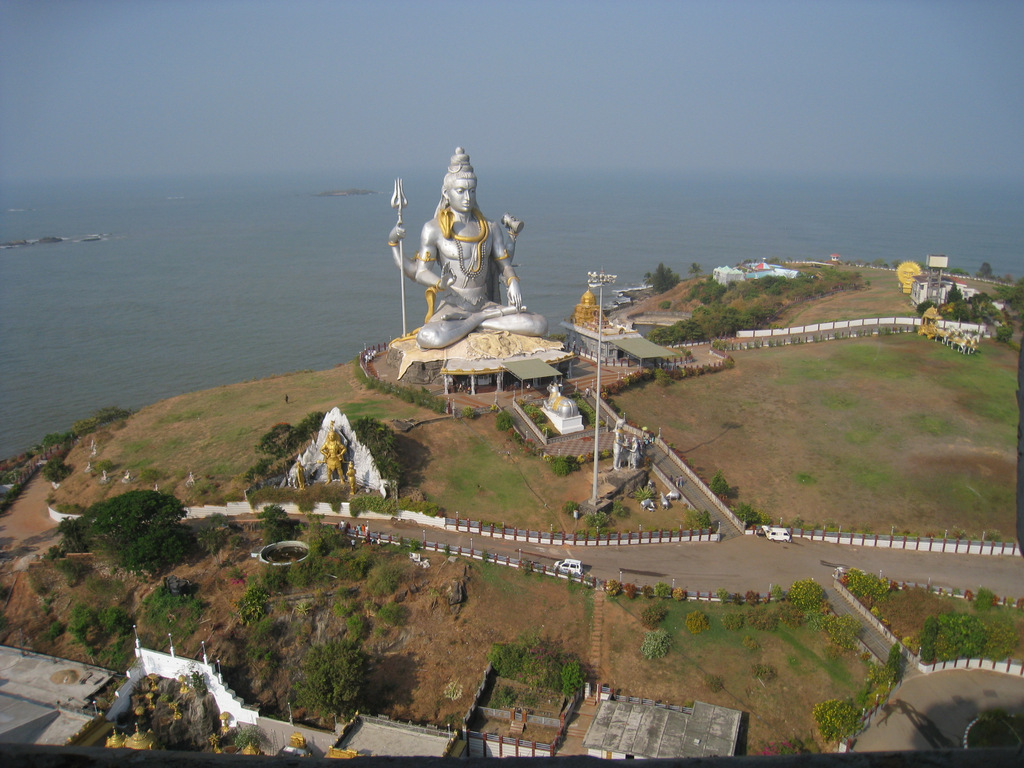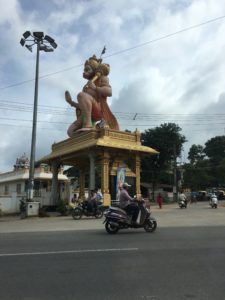Surely one reason for the ongoing but mistakenly benign and otherworldly cliché of India as a land of “spirituality” is the sheer proliferation of religious images, sounds, and smells in its public spaces. For a start, there are canonical and popular traditions dating back to precolonial times: processions bringing gods out of temples for public worship; performances that remember and relive, with joy and lamentation, mythic epics and the lives and deaths of prophets and saints; calls to prayer from mosques; bells, music, and chanting from temples and domestic shrines, pervading the atmosphere with the fragrance of flowers and smoke from burning ritual substances—incense, wood, ghee. There are built forms, from stately domes or lavishly carved and painted gopurams (gateways) and shikharas (towers over the sancta of temples), to modest wayside shrines as simple as a set of stones. These in turn segue into organic beings: trees anointed with colored powders and offerings of flowers and milk, human bodies marked by devotion or sectarian affiliation, ritual garlands floating down rivers, sacred cows, monkeys, snakes, even rats, or sidewalk fortune-tellers’ parrots, wandering, slithering, scurrying, and hopping in and out of the frame.

Layered onto these are religious appropriations of new technologies over the centuries. Woodblocks, chromolithographs, and then offset and lenticular prints, creatively deploying developments in painting and photography from Victorian history painting to Photoshop, not to mention sequins, fabric, gold dust, and LEDs. Devotional or mythological cinema and television, of course. Marching bands, recorded music, loudspeakers. Icons in every medium imaginable, ranging from plastic dashboard deities, saints, and gurus, to concrete monuments over a hundred feet tall; 3D prints, vinyl banners, devotional videos and ringtones, virtual incarnations on Facebook and WhatsApp. An excessive, overwhelming list, perhaps, but the experience of all this does not necessarily feel that way, for this teeming cornucopia of images and sensations is interwoven into the fabric of everyday life—except during festivals with their literally amped-up intensity, when, for instance, processions inundate the streets along with disco-bhajans (devotional songs) thundering from mobile walls of speakers and lights (as in this video of a Hindu festive procession passing a mosque). Or when, at Diwali, the smoke from millions of fireworks supercharges the fumes from automobiles, biomass fires, and factories, making the toxic air of India’s cities even deadlier.
Religion’s publicness can be fatal: slowly, like this, or swiftly and directly, as in the “communal riot,” first honed as a political weapon by the British colonial state, its most recent reincarnation the unchecked Hindu nationalist lynchings of beef-eating Muslims and Dalits (once called “Untouchable” or “outcaste”) in the name of protecting the sacred cow. Communal violence goes beyond the human; desecration and destruction constantly reanimate religious images, sites, and symbols.1Michael Taussig, Defacement: Public Secrecy and the Labor of the Negative (Stanford: Stanford University Press, 1999). Indeed, public defacement also infuses secular icons with sacral power and efficacy, as with the oft-targeted statues of Dalit leader and searing critic of the caste system B. R. Ambedkar. These and other public statues are now often placed in protective cages. Are these zoo-like cages an admission of their unpredictable, untamable, vital force?

As elsewhere, but more obviously, “spirituality” unfolds here through material engagements that blur—without erasing—distinctions between spirit and matter; religion, commerce, the state, and the public sphere; interiorized, individual, private faith and collective ritual performance; the “cult value” of sequestered icons or relics guarded by priests and the “exhibition value” of publicly visible artworks.2The distinction between cult value and exhibition value appears in Walter Benjamin, “The Work of Art in the Age of Mechanical Reproduction,” in Illuminations, ed. Hannah Arendt (London: Fontana Press, 1992). Prints of gods and shrines are not just representations but embodiments of the divine, watching over and blessing bureaucrats’ offices and cash registers in shops, as well as kitchen hearths, gazing down from advertising calendars or product labels as well as pilgrimage souvenirs; both big corporations and neighborhood associations sponsor the innovative public icons passionately competing for artistic prizes at the annual festivals of Durga Puja and Ganapati Utsav (Ganesh Chaturthi). In this situation, efficacy is explicitly seen as not solely a matter of human will, agency, and deliberation—though it is certainly that too, as India’s vociferous media attest. (There is no need to choose between humanist reason or liberal subjectivity and “pre-modern” or “post-human” embodiment, haptics, and affect; it is more useful to think about how and when these are variously entangled, blurred, or distinct.)
What is the significance of publicness when it attaches to the lively, efficacious presence, whether banal or spectacular, of things like icons and wish-fulfilling shrines? What kinds of publics do they mediate? Here are two possible entry points into these questions.

One is the importance of religious patronage in asserting status and maintaining social, political, and economic power, all of which (again, as elsewhere but more explicitly) are tightly interwoven. Charitable giving in India has long been subject to an ethic of anonymity, but with democratization and economic mobility nontraditional players have entered the circuits of power, and with them the need for public recognition. If you were a trader in fertilizers in the 1960s or ’70s, or a neighborhood tailor, or even a major concrete manufacturer, you would produce annual calendars for your customers and associates featuring your name along with a religious or otherwise auspicious image. If you made your fortune in the city, you might return to your hometown and build or renovate a temple, or establish a school or hospital. Or if, after the neoliberal economic reforms of the 1990s, you were a construction baron with a chain of automobile showrooms, you might do all of the above and also build a 123 ft. Shiva visible from the coastal railway, as a Bengaluru-based businessman did in 2002 in his tiny hometown, Murudeshwar (see below).

Such images address three types of audience at once: the general public, a patron’s specific community or network, and, as devotional images, a particular divinity. The processes of recognition that shore up status are refracted through all three types of address. Calendars function impersonally as advertisements, but as annual gifts they sustain face-to-face interpersonal relationships. Their auspicious content, that both performs and elicits devotion, publicly marks their donors as ethical and creditworthy (in all senses). Similarly, while temples and giant statues are visible to random strangers, this very visibility boosts their patrons’ standing in their communities as non-hereditary “big men” (they are overwhelmingly men): benefactors and brokers of resources. So, unsurprisingly, several monumental icons have appeared in the constituencies or “vote bank” strongholds of prominent politicians across a range of parties.

All this unfolds in a situation of uneven postcolonial development, where modern bureaucratic structures introduced during the colonial period have been enabled by, layered onto, and actively reconfigure “informal” systems of quasi-feudal patronage, trade, and credit based on kin and community networks. But the importance of reputation and creditworthiness here is also of a piece with neoliberal speculation, and the need to demonstrate capacity and reliability in competing for fickle, mobile capital investment. The post-reform monumental icons, in particular, switch with ease between these modes, showcasing technological and financial prowess while seeking divine blessings, soliciting development via both tourism and pilgrimage.
Individual status projects often double as assertions of community identity, scaling up to a second driver of public religiosity: struggles over political representation in a plural democracy, where differences are defined in terms of religion and caste (rather than as “multicultural”). An early instance of these struggles was the late nineteenth century revival of the Ganesh Chaturthi and Durga Puja festivals as a way of uniting the Hindu majority in its demands to the colonial state for “native” participation. In these festivals, neighborhood groups create spectacular temporary icons for public worship over several days in spaces like parks, and then take them, in massive, noisy processions, for immersion in a water body. These and other Hindu processions have a history of asserting political and territorial dominance over other communities through deliberate provocations such as passing mosques, often explicitly restaging threats of majoritarian violence (as in this chilling recent clip).

Here, as with other forms of public Hinduism, publicness has to be taken quite literally: it is about icons coming out of temples and into the open for all to worship, but also being simultaneously thrust into the faces and ears and up the noses of India’s minority communities. In this process, a very old vocabulary of power is brought to bear on modern politics, for the occupation and policing of space, particularly access to icons, has for centuries been central to the performance of social distinctions, notably those of caste and gender. Until the Temple Entry movements of the 1920s and ’30s, “Untouchables” were seen as polluting and forbidden from approaching not just the sanctum but often even the streets around a temple; informal taboos on temple entry still attach to menstruating women, as with the recent controversy at the Sabarimala temple. The ritual processions bringing icons out of temples, or the imagery on gopurams and shikharas, were concessions to those barred from access to sacred spaces.
So if the “public” is an “outside,” the “inside” against which it is defined is not just the private domestic space of the bourgeois home and family, or the inner life of the faithful individual, but also the sanctified space of the temple in the sensory regimes of caste and patriarchy. This is what makes public icons so volatile and risky, as their energies are unleashed into a world beyond the control of Brahmin priests. This is why the festive icons of Ganesh and Durga must be “cooled” in water to dissipate their power, but it is also why statues of Ambedkar elicit desecration, for both their inspirational subject and their very occupation of public space fundamentally threaten the Brahminical order. Indian religions have profound philosophical and “spiritual” dimensions, but these are also caught up in material exchanges, social relations, and sensible regimes where profound inequities are both perpetuated and contested, rendering their publicness far more fraught than all the flowers and incense and chanting might suggest. If the Hindu Right has weaponized public religion under the sign of the sacred lotus (the Bharatiya Janata Party’s election symbol), it is worth recalling that this incandescent flower is the seat of Lakshmi, the goddess of wealth, and has long, deep roots that thrive in mud, the thicker and filthier the better.
All images courtesy of the author.













Brilliant Kajri…you have brought the essence of all that goes on in the name of Bhakti ki Shakti in every form and use…. love..
Bua